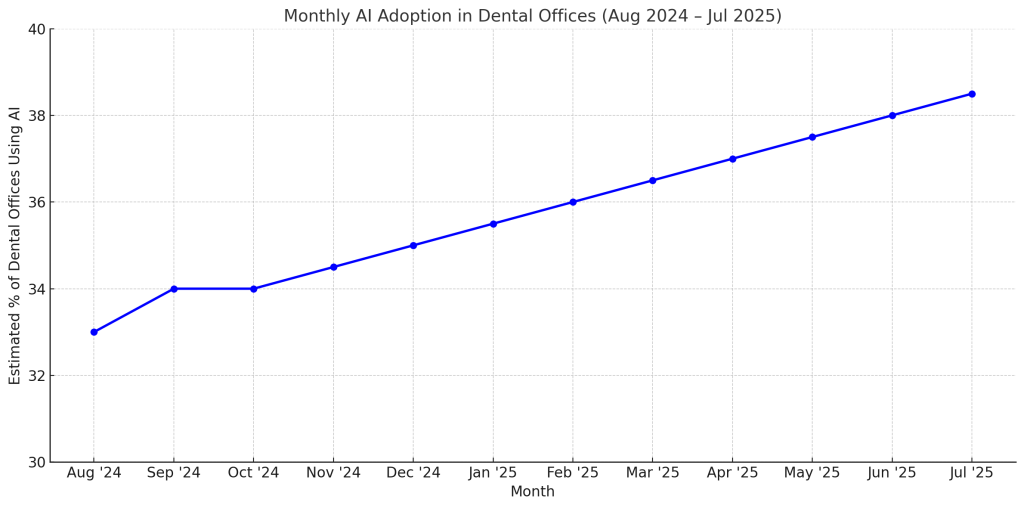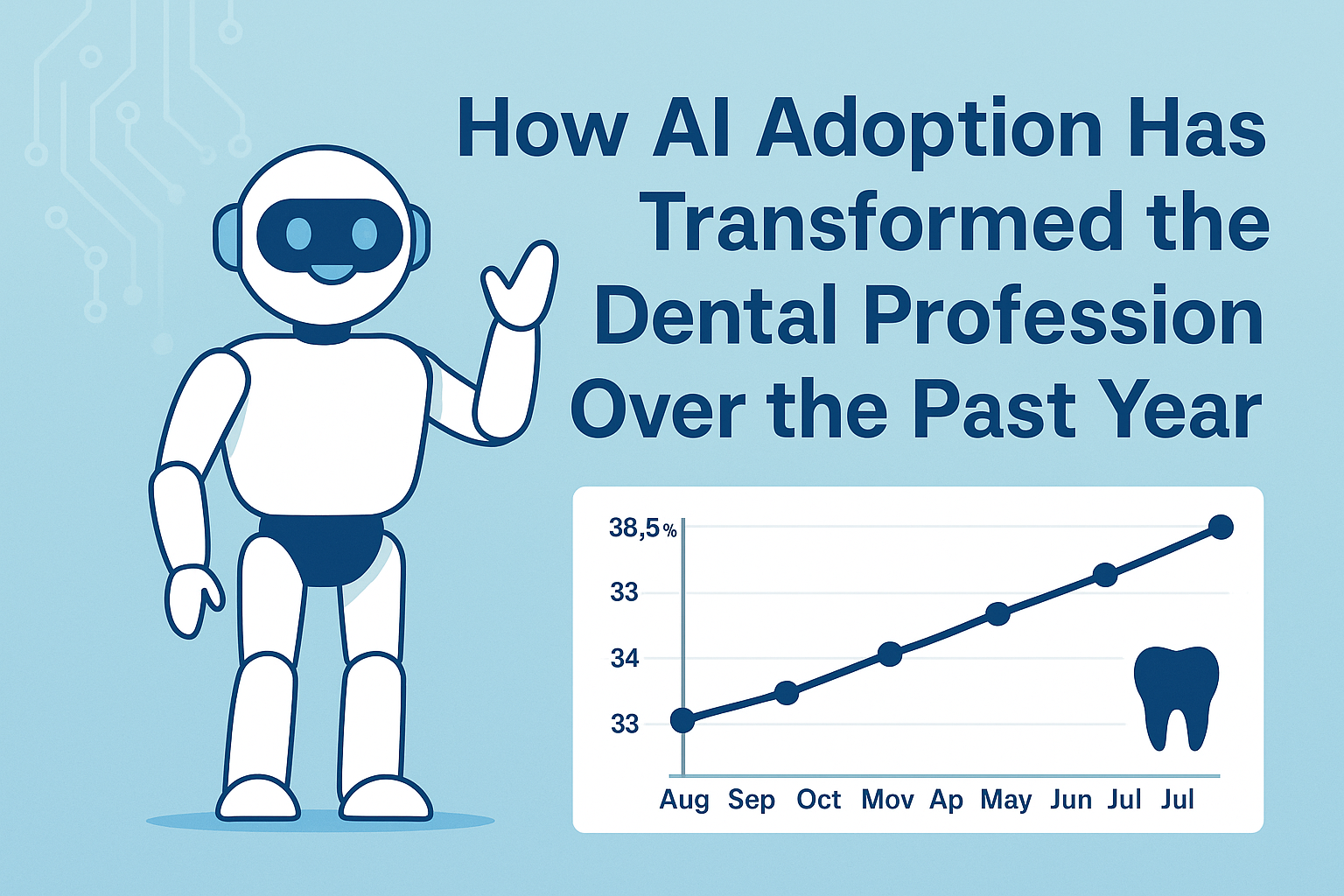In the past year, artificial intelligence (AI) has transitioned from an experimental tool to a practical necessity in the dental industry. Between August 2024 and July 2025, AI adoption in dental practices grew from 33% to 38.5%—a noteworthy rise that reflects a fundamental shift in how dental professionals deliver care, manage workflow, and communicate with patients.

But what’s driving this steady increase? And how exactly is AI reshaping the way dentists operate? In this article, we’ll explore the technologies fueling this adoption, the real-world applications changing the patient experience, and the broader impact of this digital transformation on the dental profession.
The Growth Curve: A Snapshot
As shown in the chart above, monthly AI usage in dental offices has steadily increased. While the early part of this 12-month period saw modest growth, key inflection points occurred in late 2024 and early 2025, often aligning with post-conference rollouts, new AI tool releases, and end-of-year budget allocations. Dental practices began embracing AI not only as a diagnostic assistant but also as a frontline solution to operational challenges like scheduling, insurance claims, and patient triage.
Why Has AI Use Increased in Dentistry?
The uptick in AI adoption is being fueled by several converging trends:
1. Clinical Efficiency and Accuracy
Dentists are turning to AI to support faster, more accurate diagnostics. Tools like Overjet and Pearl have FDA-cleared solutions that interpret dental radiographs with precision that rivals or exceeds human performance. These tools not only speed up diagnosis but also help dentists identify conditions—such as bone loss or early decay—that may have been missed otherwise.
2. Administrative Overload
Administrative burden has long plagued dental practices, particularly smaller offices with limited staff. AI systems are now automating tasks like insurance verification, billing, scheduling, and even follow-up reminders. The result? Less stress for front office staff and more time to focus on patient engagement.
3. Demand for 24/7 Patient Support
Patients today expect on-demand answers. With the rise of virtual assistants like The OnCall Bot and Dental Rescue Bot, practices can offer intelligent chat-based support even when the office is closed. These bots answer common dental questions, offer guidance during emergencies, and even collect information for follow-up appointments—without requiring the dentist to pick up the phone at 2 a.m.
4. DSO (Dental Service Organization) Influence
Larger DSOs are leading the charge in AI adoption. These corporate entities are quick to implement technology that reduces overhead, increases patient throughput, and ensures consistency across multiple locations. Independent dentists, seeing the competitive advantage AI offers, are beginning to follow suit.
5. AI Advancements and Cost Reduction
In the past, AI tools were cost-prohibitive for small practices. That’s changing fast. As the technology matures and becomes more widespread, the cost of entry is dropping—especially for cloud-based AI solutions that don’t require expensive hardware or lengthy installation.
Types of AI Most Commonly Used
Not all AI in dentistry is created equal. Over the past 12 months, certain types of tools have led the adoption wave:
🦷 Radiographic Analysis Tools
- Overjet: Analyzes X-rays to detect cavities, bone loss, and other dental issues.
- Pearl’s Second Opinion: Offers real-time AI evaluations during exams to confirm or challenge human findings.
- Dent.AI: Primarily used for cephalometric analysis in orthodontics.
🧠 Patient Communication Bots
- The OnCall Bot: Provides after-hours support, answering patient concerns and guiding emergency care until a dentist is available.
- Dental Rescue Bot: Tailored for patients without a current provider, helping triage and direct them to appropriate care.
- Custom Practice Bots: Offices are building AI chatbots to handle appointment bookings, FAQs, and even new patient intake.
📋 Insurance and Billing Automation
- Zentist and Jarvis Analytics help dental practices streamline insurance claims and track financial performance using predictive AI.
- Planet DDS now integrates AI in its practice management software to analyze performance trends and identify inefficiencies.
🦷 Treatment Planning and Imaging
- AI now plays a role in aligner treatment planning, 3D smile design, and implant placement simulation, making treatment plans more accurate and reducing chair time.
Real-World Impacts on the Dental Profession
The impact of AI on dentistry is not just technological—it’s deeply personal and professional. Here’s how:
📈 Better Patient Outcomes
AI-driven diagnostics are helping dentists catch issues earlier and with greater confidence. That translates to less invasive treatments, better long-term oral health, and higher patient satisfaction.
🧘 Reduced Stress for Dental Teams
Automating routine tasks has lifted an enormous burden off front office teams and clinicians. With less time spent managing logistics, teams can focus more on care and connection.
💡 Data-Driven Decision Making
AI analytics tools provide real-time dashboards that help dentists understand what’s working—and what’s not—in their practice. From appointment no-shows to treatment acceptance rates, insights are driving smarter business decisions.
🤝 Stronger Patient Relationships
Contrary to fears that AI would “depersonalize” care, many dentists report that it’s having the opposite effect. With administrative tasks handled by AI, dental teams have more time to educate, empathize, and engage with patients directly.
🦠 Post-COVID Priorities
Since the pandemic, infection control, efficiency, and remote care have become priorities. AI has stepped up to help practices become leaner, more responsive, and more resilient in unpredictable environments.
Challenges Still Ahead
Despite the gains, AI adoption isn’t without its challenges:
- Privacy and HIPAA Compliance: Practices must ensure AI tools are secure and compliant with health data regulations.
- Staff Training: The learning curve can be steep. Proper onboarding is essential to avoid misuse or underuse.
- Skepticism and Trust: Some dentists still distrust AI diagnostics or feel it threatens their clinical authority. The key lies in positioning AI as a support, not a replacement.
Looking Ahead: What’s Next?
If current trends continue, it’s likely we’ll see AI adoption cross 50% in the next two to three years. Here’s what we might expect:
- Voice-Powered Charting: Real-time dictation tools powered by AI will make note-taking effortless.
- Predictive Scheduling: AI may soon help forecast patient cancellations and optimize schedules accordingly.
- Preventive Dentistry Models: AI will move upstream to help predict which patients are most at risk before disease starts.
- AI-Powered Education: Both patients and providers will benefit from dynamic learning platforms that adapt to user behavior.
Final Thoughts
The steady growth in AI adoption over the past year reflects more than just a trend—it signals a major transformation in dental care. Dentists are no longer asking “Should I use AI?” but rather “How can I best use it to serve my patients and grow my practice?”
For those who are still on the fence, the message is clear: AI in dentistry isn’t the future—it’s the present. And as the tools become smarter and more accessible, staying ahead means staying informed, open-minded, and ready to embrace the remarkable possibilities ahead.

No responses yet